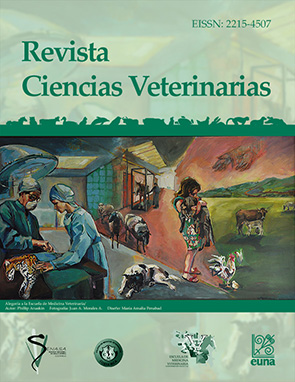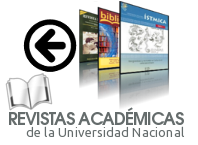Measurement of thyroid hormones and cortisol in horses with an automated immunoassay analyzer
DOI:
https://doi.org/10.15359/rcv.34-1.3Keywords:
horses, thyroid hormones, cortisol, reference interval, AIA-360®Abstract
Even though thyroid gland diseases are unusual in horses, it is important to have a reference interval for thyroid hormones in this species at every veterinary endocrine laboratory. In addition, cortisol and thyroid hormone measurement is useful in horses, not only for disease diagnosis, but as a tool for monitoring and researching performance and metabolic rate.The objectives of this study included (i) to test the capacity of the automated analyzer AIA 360® (TOSOH Bioscience) to measure thyroid hormones and cortisol in equine serum in a reliable way, and (ii) to establish a reference interval for thyroid hormones in Costa Rican horses using the AIA-360®.
A total of 68 healthy and treatment free horses (31 males and 37 females) were sampled. Horses were grouped into three different categories according to their ages. Serum concentrations of total thyroxine (TT4), free thyroxine (FT4), and cortisol were quantified with the AIA-360®. Statistic relationships of hormonal values, gender and age were determined using Kruskal-Wallis, Dunn and Wilcoxon (U Man-Whitney) tests. P <0.05 was considered significant.
Selected reference intervals were: TT4 14.16 – 46.33 nmol/L, FT4 3.60 – 16.09 pmol/L and cortisol 23.45 – 166.64 nmol/L. No statistically significant relationship was found between gender, age, and hormone values. Besides, significant relationships (p<0.05) were found between hormone levels and some environmental parameters. Animals living at higher altitudes showed higher cortisol levels, while cortisol decreases as the environmental temperature rises. Moreover, the FT4 levels are higher as precipitation increases. Finally, TT4 seems to be lower as day light length increases; however, no statistical relationship was found (p<0.30). Our results show that the use of the automated analyzer AIA-360® is suitable to measure thyroid hormones and cortisol, and that the values found are comparable with other studies and analysis techniques.
References
Ayala, I., N.F. Martos, G. Silvan, C. Gutierrez-Panizo, J.G. Clavel & Illera J.C. 2012. Cortisol, adrenocorticotropic hormone, serotonin, adrenaline and noradrenaline serum concentrations in relation to disease and stress in the horse. Res. Vet. Sci. 93:103–107. doi:10.1016/j.rvsc.2011.05.013.
Breuhaus, B.A., K.R. Refsal & Beyerlein S.L. 2006. Measurement of free thyroxine concentration in horses by equilibrium dialysis. J. Vet. Intern. Med. 20:371–376. doi:10.1892/0891-6640(2006)20[371:MOFTCI]2.0.CO;2.
Cordero, M., B.W. Brorsen & McFarlane D. 2012. Circadian and circannual rhythms of cortisol, ACTH, and α-melanocyte-stimulating hormone in healthy horses. Domest. Anim. Endocrinol. 43:317–324. doi:10.1016/j.domaniend.2012.05.005.
Di Rienzo, J.A., F. Casanove, M.G. Balzarini, L. Gonzalez, M. Tablada & Robledo C.W. 2014. InfoStat. Grupo InfoStat, FCA, Universidad Nacional de Córdoba. http://www.infostat.com.ar.
Dybdal, N., K. Hargreaves, J. Madigan, D. Gribble, P. Kennedy & Stabenfeldt G. 1994. Diagnostic testing for pituitary pars intermedia dysfunction in horses. J. Am. Vet. Med. Assoc. 204:627–32.
Eshratkhah, B., H. Rajabian, D. Namvar, S. Eshratkhah & Mohammadi Bastam S. 2010. Comparative study on determination of plasma thyroid hormones by chemiluminescence and electrochemiluminescence immunoassay methods in sheep. Comp. Clin. Path. 20:135–138. doi:10.1007/s00580-010-0967-8.
Graves, E. A., H.C. Schott, J.V. Marteniuk, K.R. Refsal & Nachreiner R.F. 2006. Thyroid hormone responses to endurance exercise. Equine Vet. J. Suppl. 36:32–36. doi:10.1111/j.2042-3306.2006.tb05509.x.
Haritou, S.J., A.R. Zylstra, C. Ralli, S. Turner & Tortonese D.J. 2008. Seasonal changes in circadian peripheral plasma concentrations of melatonin, serotonin, dopamine and cortisol in aged horses with Cushing’s disease under natural photoperiod. J. Neuroendocrinol. 20:988–996. doi:10.1111/j.1365-2826.2008.01751.x.
Higgs, P., M. Costa, A. Freke & Papasouliotis K. 2014. Measurement of thyroxine and cortisol in canine and feline blood samples using two immunoassay analysers. J. Small Anim. Pract. 55:153–159. doi:10.1111/jsap.12181.
Hilderbran, A.C., B.A. Breuhaus & Refsal K.R. 2014. Nonthyroidal illness syndrome in adult horses. J. Vet. Intern. Med. 28:609–617. doi:10.1111/jvim.12274.
IMN (Instituto Meteorológico Nacional de Costa Rica). 2015. Datos e información meteorológica de Costa Rica en el periodo de febrero a setiembre de 2014. San José, Costa Rica. DI-153-0615/ DI-179-0615 pp.
Kheirkhah, H.A. & Hassanpour A. 2013. Evaluation of serum levels of thyroid hormones and cortisol in arabian horses with gastric ulcer. 2:109–115.
Lathe, R. & Kotelevtsev Y. 2014. Steroid signaling: Ligand-binding promiscuity, molecular symmetry, and the need for gating. Steroids. 82:14–22. doi:10.1016/j.steroids.2014.01.002.
Liburt, N.R., K.H. McKeever, K. Malinowski, D.N. Smarsh & Avenatti R. 2013. Response of the hypothalamic-pituitary-adrenal axis and glucose homeostasis during and in recovery from acute exercise, before and after training in old and young Standardbred mares. J. Equine Vet. Sci. 33:327–328. doi:10.1016/j.jevs.2013.03.024.
Mair, T. & Sherlock C. 2009. Daily serum concentrations in horses with colic requiring exploratory celiotomy. In 55th Annual Convention of the American Association of Equine Practitioners. 483–486.
Mair, T.S., C.E. Sherlock & Boden L.A. 2014. Serum cortisol concentrations in horses with colic. Vet. J. 201:370–377. doi:10.1016/j.tvjl.2014.06.005.
Medica, P., E. Fazio, C. Cravana & Ferlazzo A. 2011. Influence of endemic goitre areas on thyroid hormones in horses. Animal. 5:82–87. doi:10.1017/S175173111000145X.
Mendoza, F.J., R.A. Perez-Ecija, R.E. Toribio & Estepa J.C. 2013. Thyroid hormone concentrations differ between donkeys and horses. Equine Vet. J. 45:214–218. doi:10.1111/j.2042-3306.2012.00622.x.
Meredith, T.B. & Dobrinski I. 2004. Thyroid function and pregnancy status in broodmares. J. Am. Vet. Med. Assoc. 224:892–4.
MINAET (Ministerio de Ambiente, Energía y Telecomunicaciones) & IMN (Instituto Meteorológico Nacional de Costa Rica). 2009. Segunda Comunicación Nacional a la Convención Marco de la Naciones Unidas sobre Cambio Climático. San José Costa Rica. 67-78 pp.
Morris, D.D. & García M.C. 1985. Phenylbutazone and anabolic steroids on adrenal and thyroid gland function test in healthy horses. Am. J. Vet. Res. 46:359–364.
Mullur, R., Y.Y. Liu & Brent G.A. 2014. Thyroid hormone regulation of metabolism. Physiol. Rev. 94:355–382. doi:10.1152/physrev.00030.2013.
Peeters, M., J. Sulon, J.F. Beckers, D. Ledoux & Vandenheede M. 2011. Comparison between blood serum and salivary cortisol concentrations in horses using an adrenocorticotropic hormone challenge. Equine Vet. J. 43:487–493. doi:10.1111/j.2042-3306.2010.00294.x.
Schenk, P., R. Nachreiner, K. Refsal, M. Mazaki-Tovi & Sist M. 2012. Endocrinology reference ranges: Diagnostic Center for Pupulation and Animal Healt- Michigan State University. WEBCD.ENDO.REF.004.0 9. 1.
Schott, H.C. 2002. Pituitary pars intermedia dysfunction: equine Cushing’s disease. Vet. Clin. North Am. Equine Pract. 18:237–70.
Singh, A.K., Y. Jiang, T. White & Spassova D. 1997. Validation of nonradioactive chemiluminescent immunoassay methods for the analysis of thyroxine and cortisol in blood samples obtained from dogs, cats, and horses. J. Vet. Diagn. Invest. 9:261–268. doi:10.1177/104063879700900307.
Suárez-Esquivel, M. & Castro-Ramírez L. 2012. Niveles séricos de tetrayodotironina, triyodotironina y cortisol en caninos de Costa Rica mediante un analizador de inmunoensayo. Rev. Ciencias Vet. 30:25–37.
Wheeler, M.J. 2013. A Short History of Hormone Meassurement. Methods Mol. Biol. 1065:1–6. doi:10.1007/978-1-62703-616-0_1.
Wood, S. & Loudon A. 2014. Clocks for all seasons: unwinding the roles and mechanisms of circadian and interval timers in the hypothalamus and pituitary. J. Endocrinol. 222:R39–R59. doi:10.1530/JOE-14-0141.
Downloads
Published
How to Cite
Issue
Section
License
Licensing of articles
All articles will be published under a license:

Licencia Creative Commons Atribución-NoComercial-SinDerivadas 3.0 Costa Rica.
Access to this journal is free of charge, only the article and the journal must be cited in full.
Intellectual property rights belong to the author. Once the article has been accepted for publication, the author assigns the reproduction rights to the Journal.
Ciencias Veterinarias Journal authorizes the printing of articles and photocopies for personal use. Also, the use for educational purposes is encouraged. Especially: institutions may create links to specific articles found in the journal's server in order to make up course packages, seminars or as instructional material.
The author may place a copy of the final version on his or her server, although it is recommended that a link be maintained to the journal's server where the original article is located.
Intellectual property violations are the responsibility of the author. The company or institution that provides access to the contents, either because it acts only as a transmitter of information (for example, Internet access providers) or because it offers public server services, is not responsible.







